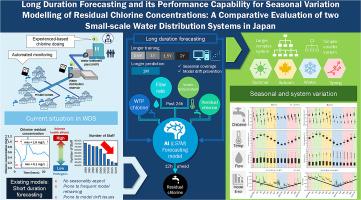当前位置:
X-MOL 学术
›
Water Res.
›
论文详情
Our official English website, www.x-mol.net, welcomes your
feedback! (Note: you will need to create a separate account there.)
Long Duration Forecasting and its Performance Capability for Seasonal Variation Modelling of Residual Chlorine Concentrations: A Comparative Evaluation of two Small-scale Water Distribution Systems in Japan
Water Research ( IF 11.4 ) Pub Date : 2024-11-08 , DOI: 10.1016/j.watres.2024.122766 Ginalyn Robel Marzan Brazil, Yasuhiro Arai, Takuma Iwamoto, Muhammad Anshari Caronge, Takaharu Kunizane, Akira Koizumi
Water Research ( IF 11.4 ) Pub Date : 2024-11-08 , DOI: 10.1016/j.watres.2024.122766 Ginalyn Robel Marzan Brazil, Yasuhiro Arai, Takuma Iwamoto, Muhammad Anshari Caronge, Takaharu Kunizane, Akira Koizumi

|
Chlorine dosing control is a critical task for health security, complying with drinking water quality standards while achieving customer satisfaction. In Japan, this became more difficult due to decreasing number of technical personnel as a result of declining population and huge retirement of veterans. As experienced-based dosing control still exists and is considered inefficient due to risks of inaccurate dosing and need of experienced manpower, streamlining of operations is needed. This study aims to address these concerns through the development and evaluation of a deep learning model for residual chlorine concentrations capable of forecasting long durations. In this paper, the model is investigated in seasonal timeframe analyzing trends and variations. Two water distributions systems of varying network—simple and complex, are also compared to further analyze model performance and versatility. The model utilizes the past 24 hours of flow rate, chlorine level at treatment plant, water temperature, and residual chlorine at private homes as input to predict the 12 hours ahead of residual chlorine at private homes evaluated at hourly training lengths of 0.5, 1, 1.5, 2 years. Results revealed that the model achieved high accuracy in predicting hourly residual chlorine with general increasing model error from winter, spring, autumn, and summer due to the progressing instabilities in chlorine concentrations from low to high temperatures. Moreover, smaller system tends to be more unstable incurring lower model performance relative to larger system. In terms of optimal training length, ≥1Y training models are found to have lesser chance of data drift occurrence prospectively reducing model retraining frequency in the future.
中文翻译:

长时预测及其对余氯浓度季节性变化建模的性能能力——日本两种小规模配水系统的比较评价
氯剂量控制是健康安全的一项关键任务,在满足饮用水质量标准的同时满足客户满意度。在日本,由于人口减少和退伍军人大量退休,技术人员数量减少,这变得更加困难。由于基于经验的剂量控制仍然存在,并且由于剂量不准确的风险和需要经验丰富的人力而被认为效率低下,因此需要简化操作。本研究旨在通过开发和评估能够预测长时间的余氯浓度深度学习模型来解决这些问题。在本文中,在季节性时间框架中分析趋势和变化,对模型进行了研究。此外,还比较了两个不同管网(简单和复杂)的配水系统,以进一步分析模型的性能和多功能性。该模型利用过去 24 小时的流速、处理厂的氯含量、水温和私人住宅的余氯作为输入,以 0.5、1、1.5、2 年的每小时训练长度评估私人住宅的余氯提前 12 小时。结果表明,该模型在预测每小时余氯方面取得了很高的准确率,由于氯浓度从低温到高温的不稳定性,冬季、春季、秋季和夏季的模型误差普遍增加。此外,较小的系统往往更不稳定,相对于较大的系统,模型性能较低。在最佳训练长度方面,发现 ≥1Y 训练模型发生数据漂移的可能性较小,从而有望在未来降低模型重新训练频率。
更新日期:2024-11-09
中文翻译:

长时预测及其对余氯浓度季节性变化建模的性能能力——日本两种小规模配水系统的比较评价
氯剂量控制是健康安全的一项关键任务,在满足饮用水质量标准的同时满足客户满意度。在日本,由于人口减少和退伍军人大量退休,技术人员数量减少,这变得更加困难。由于基于经验的剂量控制仍然存在,并且由于剂量不准确的风险和需要经验丰富的人力而被认为效率低下,因此需要简化操作。本研究旨在通过开发和评估能够预测长时间的余氯浓度深度学习模型来解决这些问题。在本文中,在季节性时间框架中分析趋势和变化,对模型进行了研究。此外,还比较了两个不同管网(简单和复杂)的配水系统,以进一步分析模型的性能和多功能性。该模型利用过去 24 小时的流速、处理厂的氯含量、水温和私人住宅的余氯作为输入,以 0.5、1、1.5、2 年的每小时训练长度评估私人住宅的余氯提前 12 小时。结果表明,该模型在预测每小时余氯方面取得了很高的准确率,由于氯浓度从低温到高温的不稳定性,冬季、春季、秋季和夏季的模型误差普遍增加。此外,较小的系统往往更不稳定,相对于较大的系统,模型性能较低。在最佳训练长度方面,发现 ≥1Y 训练模型发生数据漂移的可能性较小,从而有望在未来降低模型重新训练频率。


















































 京公网安备 11010802027423号
京公网安备 11010802027423号